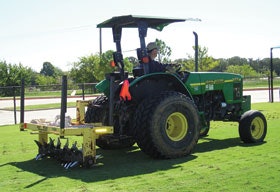The benefits of field aeration are well understood, though there are many different ways to achieve them.

Sounds simple. Yet, how to get the best results, and which aeration equipment to purchase, are areas deserving of careful consideration.
Aerators for sports field applications are typically tractor-drawn units, with walk-behind aerators sometimes utilized in smaller applications. The simplest rely on the weight of the equipment to force tines into the soil, while more "aggressive" equipment uses mechanical or hydraulic means to drive the tines deeper. The most aggressive machines "shatter" the soil profile either by utilizing twisted tines or by moving tines in a heaving or vibrating action as well as up and down. Beyond that, tines can either be made of solid steel (which limits the disruption of the soil surface), or hollow-core or spoon-shaped steel (which pulls soil cores and deposits them on the surface). And since aeration of fields is often performed in concert with overseeding, some aeration equipment includes a seed box that allows both operations to take place simultaneously.
All of the different types of equipment have their adherents - and each of the equipment manufacturers have marketing budgets - making choosing between them sometimes difficult. Few studies have been performed that definitively answer equipment purchasing questions, although there are some basic truths out there:
- Core aeration generally is more effective than solid-tine aeration, since it allows for greater compaction relief and the holes it creates don't close as fast, but solid-tine aeration can be performed regularly without rendering the field unplayable. In addition, the cores left behind by hollow-tine aerators must be picked up, crushed with a roller or dragged back into the profile, adding to field maintenance time and cost. Field maintenance programs often include annual, semi-annual or seasonal core aeration, supplemented by more frequent solid-tine aeration as a means of short-term oxygen and water infiltration.
- Both deep-tine aeration and shallow-tine aeration (with a minimum tine length of 3 inches) do a good job of getting water, air and nutrients to the root zone. However, deeper aeration (with tines as long as 8 inches) will lead to deeper root zones, which will generally allow irrigation intervals to be lengthened and fertilizer applications to last longer. That said, deep-tine aeration equipment is more expensive than shallow-tine equipment, and will lead to an expensive mistake if care isn't taken to ensure the tines aren't longer than a field's irrigation system is deep.
- Different areas of a field, different climatic conditions and different times in the life of a field will require different types of equipment. A few examples: Deep-tine aeration is best used in front of soccer goalmouths and between football hash marks. A field that is damp won't respond well to equipment that produces a "shattering" action. Shallow, solid-tine equipment won't relieve compaction nearly as well as it will open the thatch surface to allow for quick water and air penetration with minimal disturbance to the surface.
The Iowa State Extension web site features a coring chart (turfgrass.hort.iastate.edu/extension/core.pdf) that spells out the particulars of various coring and topdressing programs, with variables taken into account such as the spacing and depth of aeration holes, and the diameter of the tines used. An accompanying article offers as an example a maintenance specialist's goal of removing 50 percent of a predominantly clay field to a depth of the aerator tine and replacing it with sand. "If you remove cores on 3-inch centers, it will require 22 passes over the field using 1/2-inch-diameter hollow tines in order to meet your goal," the article notes. "At two corings per year, this would require 11 years, and that might be too long to wait. By using 3/4-inch tines you can achieve the same goal in 10 passes over the field."
Why the focus on core aeration at the exclusion of all other aeration methods? Minner maintains that the differences between types of aerators is less important than the amount of time spent actually poking holes in your fields. Noting a University of Georgia study that ranked an oscillating solid-tine aeration machine number one in compaction relief in the top 5 inches of soil, Minner says, "I don't subscribe to much of that. There are a lot of effective pieces of equipment out there, but most people try to pick a strategy that fits their budget. I think everybody would agree if they're given an opportunity to purchase one piece of equipment and they can afford the top of the line, they'll buy a good hollow-tine aerator, because it's the most versatile."




































